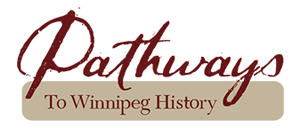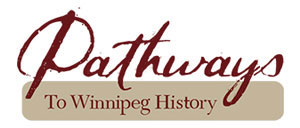An Act of Imagination
WHEREAS a great number of the inhabitants of Winnipeg have represented that it is desirable that the same should be incorporated as a City under the name of Winnipeg…
The Official Beginning
An Act to Incorporate the City of Winnipeg was passed by the Manitoba Legislature on November 8, 1873. WinnipegHistorian Alan Artibise has noted that the word "Winnipeg" was first used in 1866 on the title page of the Nor'Wester, the primary newspaper in the region from 1859. Prior to this issue, the designation "Red River Settlement, Assiniboia" had appeared in its masthead. By 1870, maps of the area referred to the town of "Winnipeg", though it was not incorporated until 1873. In 1876, the name of the post office was formally changed to Winnipeg. The word "Winnipeg" comes from the Cree name for the lake to the north of the City. It means: "win", muddy; "nipee", water.
X Close was officially a city, though not without event.
After considerable debate, the original bill for incorporation was thrown out. At issue was civic taxation and the financial burden this would impose on major property holders. Dissatisfied with this outcome, supporters of the bill waylaid Dr. Bird,Curtis James Bird was born in 1838 in Middlechurch, Manitoba. He was educated locally at St. John’s College and studied medicine in London, England. Dr. Bird served as coroner for the District of Assiniboia, was a member of the Council of Assiniboia and an MLA following creation of the Province of Manitoba. While Speaker of the Assembly, Bird ruled against the bill for incorporation of the City of Winnipeg. The bill was later reintroduced and passed in November of 1873. Dr. Bird died in London, England in 1876.
X Close Speaker of the House, and poured a pail of hot tarTarring and feathering was a form of punishment or humiliation. Typically, the victim was coated with hot tar and then covered with feathers. Dr. Bird was singled out because he ruled against an amendment and threw out the bill to incorporate the City of Winnipeg. The bill was reintroduced and passed in November of 1873.
X Close over his head and shoulders.
Despite its raucous beginnings, the Act set out essential powers for Council and would guide the new city through its early years.
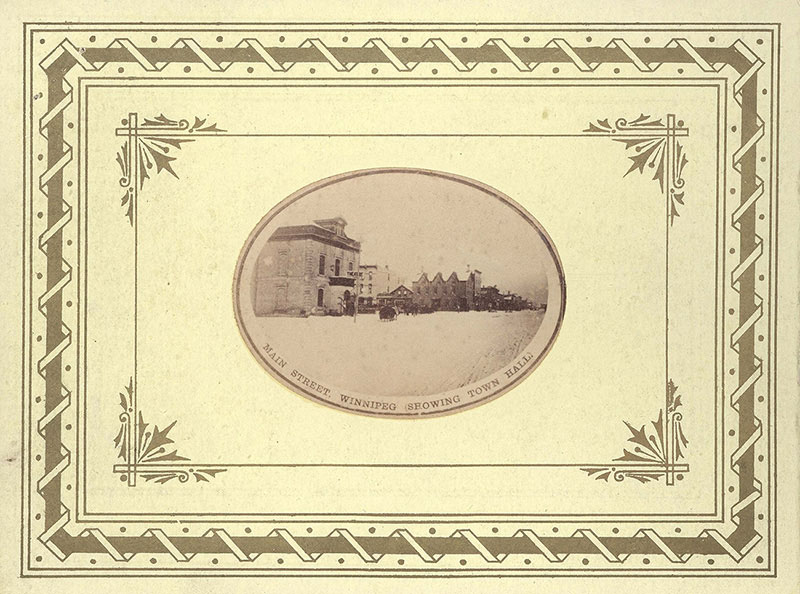
Main Street, Winnipeg, Showing Town HallPrior to construction of the first city hall, City Council met in a room on the upper story of L. R. Bentley’s "new" building on Main Street known as the "Flat Boat Store". The room is described as follows: "It is large and well-finished, with lofty arched ceiling, centrally located and in every way well adapted for the purpose for which it is intended. About one third of the room is set apart for the use of the Council, and is separated from the ‘gallery’ by a neat railing. Inside of this is a semi-circular table, covered with red cloth, around which the members will sit, while the Mayor will occupy a chair on a round dais. Two tables have been provided for the use of reporters – in fact, everything in the way of fitting up the room has been well and creditably done." Manitoba Free Press, January 24, 1874 (p. 2). |
A City Proper
Winnipeg at incorporation consisted of about three square miles of prairie soil. It’s southern and eastern boundaries were marked by the Red and Assiniboine Rivers. Present-day Maryland Street, Notre Dame Avenue and McPhillips Street marked its western limits, while Burrows Avenue west of Main Street and Aberdeen Avenue east of Main Street defined its northern boundary. A precise description of the City’s boundariesWinnipeg’s boundaries, as defined in the 1873 Act: "Commencing where the northerly limit of lot 224 in the Parish of St. John, according to the Hudson’s Bay Company’s Register, strikes the water’s edge of the Red River; thence north-westerly along the said limit of said lot to where the same intersects the eastern limit of the main highway from Winnipeg to the lower parishes; thence along the said highway southerly across the said lot 224; thence north-westerly along the southerly limit of the said lot to the rear thereof; thence southerly along the rear of the lots in the settlement belt to the westerly angle of lot 240, originally bought from the Hudson's Bay Company by William Drever; thence south-easterly along the southerly limit of the said lot 240, to where the same would be intersected by the extension of the easterly limit of the street laid out by the said Hudson’s Bay Company between lot, pensioner’s 54, and lot 1212 fronting on the Assiniboine River; thence southerly along the east limit of the said street to the Water’s edge on the said Assiniboine River; and thence along the latter easterly to the Red River; and thence down the westerly edge of the same with the stream to the place of beginning."
X Close was included in the Act.

Sketch of the City of Winnipeg, Manitoba. 1874. Winnipeg as it is in 1874; and as it was in 1860. George B. Elliott of the Canadian Press. Ottawa. 1875. (pp. 37). |
Ward Boundaries
Also defined in the Act were boundaries for each of the City’s four original wards:A ward is a division or district of a city or town, used for political and administrative purposes.
X Close North, South, East and West. A major change occurred in 1881 when Fort Rouge became Ward One and existing wards to the north of the Assiniboine River were reorganized into Wards Two through Six.
Elmwood was added as Ward Seven in 1906. This was the City's first extension across the Red River.
In 1920, the City’s seven wards were collapsed into three – Wards One and Two became Ward One; Wards Three and Four became Ward Two; and Wards Five, Six and Seven became Ward Three.
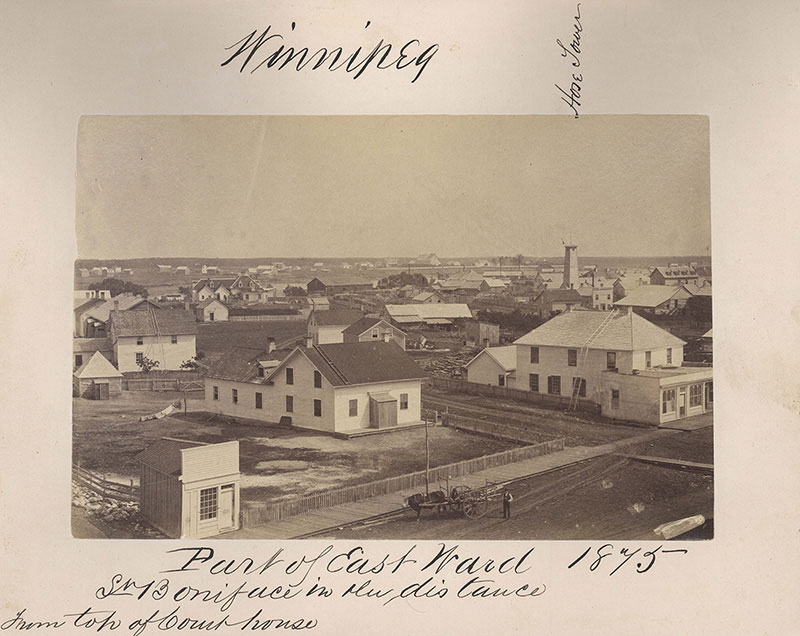
Part of East Ward. 1875. St. Boniface in the distance. From top of Court House. (A569 File 1 Item 4) |
To Run for Office
The Act also laid out qualifications for candidates who wanted to run for mayor or alderman in the City’s first election – they had to be male freeholdersA freeholder is someone who owns property.
X Close or householdersA householder is someone who occupies property.
X Close, natural born or naturalizedTo be eligible to run for office or to vote, citizens had to be British subjects by birth or become British subjects through naturalization. During times of political turmoil or economic uncertainty, questions were raised about who could be “naturalized”. At the outset of the First World War, City Solicitor Theodore A. Hunt suggested that “educational tests should be applied to all applicants who desire to become naturalized citizens of Canada.”
X Close subjects of Her Majesty, twenty-one years of age or more and resident in the City for three months prior to the election.
After the first election, candidates had to meet a property qualificationThe property qualification reflects an early attitude in civic politics – that people who owned property had a greater stake in civic affairs than those who did not. Both candidates for office and potential voters had to meet property qualifications.
The 1873 Act of Incorporation for Winnipeg set out the following property qualification for candidates for the office of mayor or alderman: shall be possessed of real estate within the City or Ward therein to the value of two thousand dollars, and the householders within the said City who shall have resided in the City or Ward for at least six months next preceding such election, of property to the value of two hundred dollars, or a rental of three hundred dollars per annum.
To be eligible to vote, citizens had to own property valued at $100 or more. In 1882, the property qualification was increased to $500. Many people did not meet this requirement and were not able to vote. It was not until 1942 that the property qualification was eliminated.
X Close. It was not until 1918 that this requirement for candidates for alderman was abolished. The property requirement for mayoralty candidates was dropped in 1920 through a Charter amendment.

Nomination Meeting, December 28, 1874. For the office of Mayor, City of Winnipeg, for Council year 1875. Election Papers, 1874. (A787 File 1) |
Right to Vote
For the first civic election in 1874, voters had to be male, 21 years of age, British subjects by birth or naturalizationTo be eligible to run for office or to vote, citizens had to be British subjects by birth or become British subjects through naturalization. During times of political turmoil or economic uncertainty, questions were raised about who could be “naturalized”. At the outset of the First World War, City Solicitor Theodore A. Hunt suggested that “educational tests should be applied to all applicants who desire to become naturalized citizens of Canada.”
X Close, resident in the City at least three months prior to the election and own property valued at $100.00 or more or pay at least $20.00 per year in rent.
The complete Voters List for the 1874 election was printed in the Manitoba Free Press on December 6, 1873. It was compiled by William Nassau KennedyWilliam Nassau Kennedy came to Red River in 1869 with Colonel Wolseley. He commanded the Winnipeg Field Battery and the 90th Winnipeg Battalion of Riffles. In 1884-1885, he led a group of voyageurs who went to serve with the British Army on the Nile expedition. He died in London on May 3, 1885.
X Close, acting City ClerkThe role of the city clerk is to record proceedings, advise on precedents and procedures, and to act as the Registrar or Returning Officer for civic elections. There have been fifteen City Clerks for Winnipeg.
1874-1883 Alexander M. Brown
1883-1926 Charles J. Brown
1926-1935 Magnus Peterson
1935-1945 George Frederick Bentley
1945-1948 Leslie Montague Ault
1948-1962 George L. Gardner
1962-1964 J. B. Kinnear
1964-1966 T. Mitchell
1966-1976 W. A. Quayle
1976-1979 H. E. Sanger
1970-1986 R. J. Fergusson
1986-1987 M. G. McCullough
1987-1991 R. B. Hayes
1992-2000 Dorothy E. Browton
2001-to date Richard Kachur
X Close and Registrar for the first election.
Only 398 residents of the new City met the qualifications to vote.
| North Ward 92 | South Ward 86 |
| East Ward 123 | West Ward 97 |
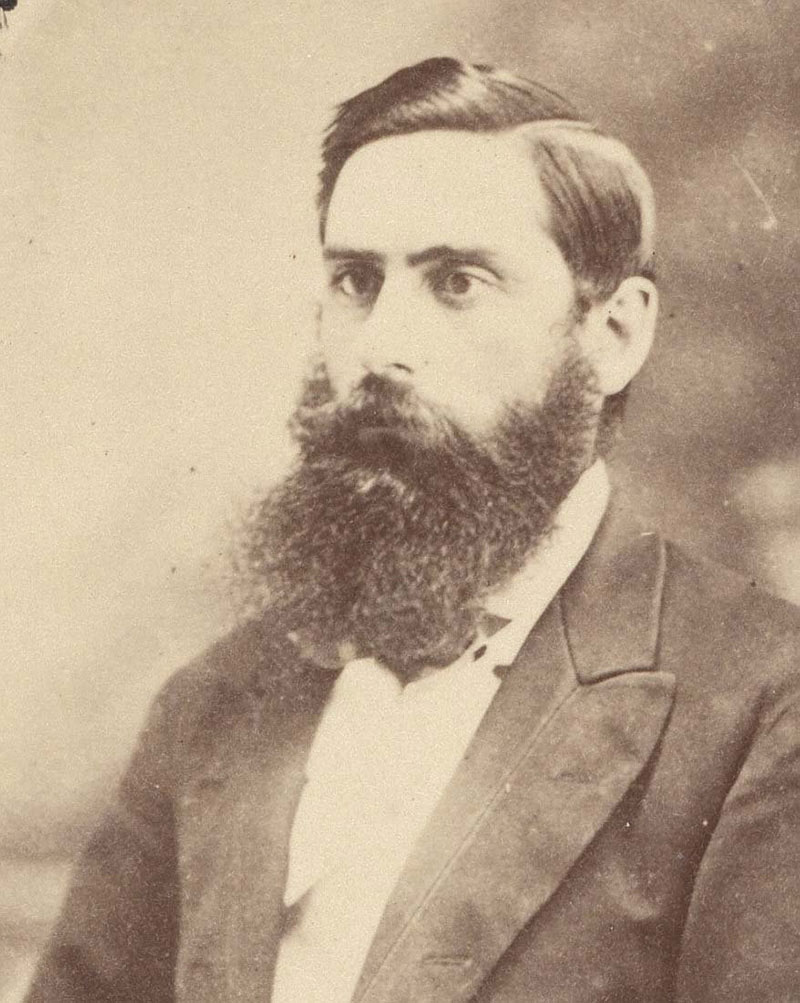
William Nassau Kennedy. Detail from photomontage, Members and Officials of the Council of the City of Winnipeg, 1875. (A569 File 1 Item 2) |
City Hall
Not long after incorporation, City Council proposed construction of a city hall. A site on Main Street between William and Market Avenues was selected. On August 17, 1875, the cornerstone of the new city hall was laid. A casket was deposited into the cornerstone – the casket contained coins, bills, newspapers and photographs of the City. Today, such a box would be called a time capsule.
Completed in 1876, the first city hall suffered chronic structural problems. It was finally judged unsound and demolished in 1883.
Winnipeg’s second city hall, the so-called "Gingerbread" building was constructed shortly after in 1886. It was demolished in 1962 to make way for construction of the present civic centre.
![Detail from View of Main Street looking north, showing Winnipeg’s first city hall, [188-?].](/clerks/archives/pathways/images/AnActOfImagination/AnActOfImagination_12.jpg)
Detail from View of Main Street looking north, showing Winnipeg’s first city hall, [188-?]. |
First City Council
Winnipeg’s first election was held on January 5, 1874. The City’s first elected aldermenThe word alderman comes from the Old English ealdorman, meaning a member of a city legislative body. In 1972, the City of Winnipeg replaced the term Alderman with Councillor.
X Close were:
North Ward: John Byron More; William Gomez Fonseca; Alexander Logan.
South Ward: James McLenaghan; Herbert Swinford; Thomas Scott (resigned May 12, 1874); John Robson Cameron.
East Ward: W. B. Thibaudeau; Andrew Strang; Robert Mulvey.
West Ward: James H. Ashdown; Archibald Wright; John Higgins.

Members and Officials of the Council of the City of Winnipeg, 1874. (A569 File 1 Item 1) |
Winnipeg's First Mayor
The mayorThe mayor is elected at large by electors in all city wards and is the head of City Council. Up to 1955, the mayor served a one year term. From 1955 to 1972, the term of office was two years. Following amalgamation in 1972, the term was extended to three years. In 1998, the term was again extended to four years. See the list of Winnipeg’s mayors from incorporation to date.
X Close was – and still is – elected at large. Francis Evans CornishFrancis Evans Cornish was one of Winnipeg’s “colourful” founding fathers. Cornish has been called a scoundrel and a rascal, though these traits were not uncharacteristic for Winnipeg in its early years. Born in 1831, Cornish came to Winnipeg in 1872 after serving as Mayor in London, Ontario. He studied law and became a Queen’s Counsel at age 26. Cornish was elected as Winnipeg’s first mayor in 1874 and served one term. He died in 1878.
X Close was Winnipeg’s first mayor. He ran against William F. LuxtonWilliam Fisher Luxton was born in England in 1844. He immigrated to Canada with his family in 1855 and came to Winnipeg in 1871. In 1872, he started the Manitoba Free Press. He ran for mayor in 1874, but was defeated by F. E. Cornish. Luxton served as a school trustee, an MLA (Rockwood, 1874-1878) and an MP (South Winnipeg, 1886-1888). He died in1907.
X Close, and won by a slim thirty-four vote majority. Until 1955, when the term of office for the mayor was changed to two years, the mayor was elected for a one-year term.
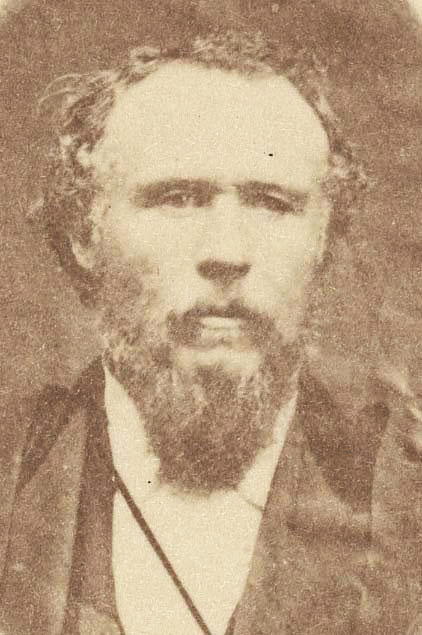
Francis Evans Cornish. Detail from photomontage, Members and Officials of the Council of the City of Winnipeg, 1874. (A569 File 1 Item 1) |
Women Receive the Civic Franchise
In 1884, Council considered a letter from James French![]() suggesting that women be granted voting privileges if they met all other qualifications. His letter was timely, as a national debate around female suffrage was then underway. While the issue was dropped by the dominion government, women in Winnipeg received the civic franchise late in 1887. Four hundred and seventy-six women were eligible to vote in the civic election of 1888, and eighty women voted in this election.
suggesting that women be granted voting privileges if they met all other qualifications. His letter was timely, as a national debate around female suffrage was then underway. While the issue was dropped by the dominion government, women in Winnipeg received the civic franchise late in 1887. Four hundred and seventy-six women were eligible to vote in the civic election of 1888, and eighty women voted in this election.
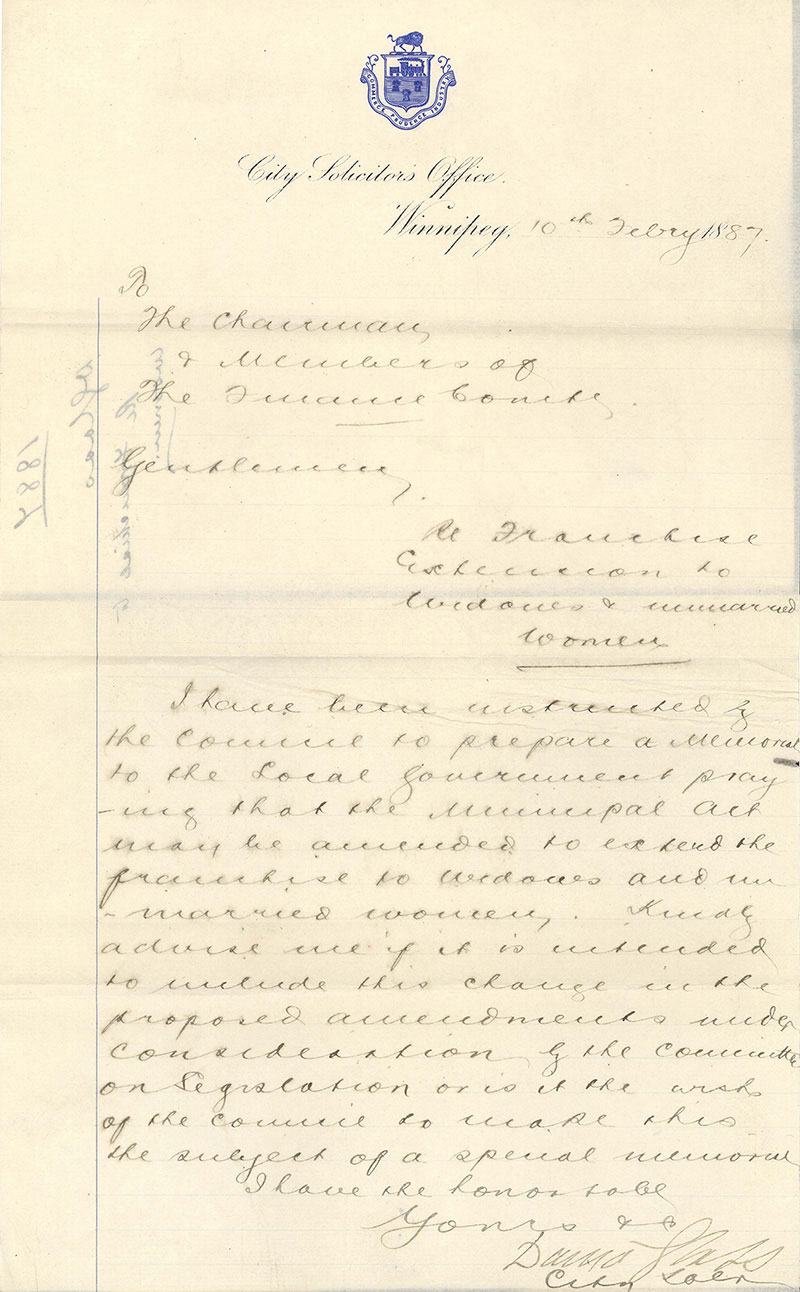
Council CommunicationsCity Solicitors Office, Winnipeg 10th February 1887, The Chairman & Members of The Finance Committee, Gentlemen: Re: Franchise extension to widows & unmarried women. I have been instructed by the Council to prepare a memorial to the Local Government praying that the Municipal Act may be amended to extend the franchise to widows and unmarried women. Kindly advise me if it is intended to include this change in the proposed amendments under consideration by the committee on Legislation or is it the wish of the council to make this the subject of a special memorial? I have the honor to be Yours, David Glass, City Solicitor |
A Profile of City Council
During Winnipeg’s first fifty years, elected officials were typically members of the City’s English Protestant elite. But there were exceptions.
Reflecting the ethnic diversity of the City’s north end, electors in Ward 5 chose Arni FredericksonVery little is known about Arni Frederickson. His nomination papers state that he was a grocer.
X Close in a by-election in 1891. Arni EggertsonArni Eggertson was born in Iceland on May 8, 1873, the son of Eggert and Sigridur Johnson. He came to Winnipeg in 1887 and was educated here in the public school system and at business college. In addition to serving a two year term as alderman, Eggertson was a member of the parks board and the general hospital board. Eggertson was a broker and builder, Vice-President of the National Security Co. and a Director of the Winnipeg Fire Insurance Co. He died in 1942.
X Close was elected in Ward 4 in 1906. Both of these men were Icelandic.
Also in Ward 5, electors chose Jewish candidates Moses Finkelstein Moses Finkelstein was born in Russia on January 12, 1873. He arrived in Winnipeg in 1882 with his father, and received his education here in the public school system. In 1889, he was elected first president of the Jewish Literary Society. He also served as president of Shaarey Zedek Synagogue, as a justice of the peace, and as a trustee of the Jewish Orphanage. He was a member of the B’nai B’rith and chairman of the building committee of the Talmud Torah. In 1900, Finkelstein started the North West Hide and Fur Company, which he later sold to the Hudson’s Bay Company. He died in Los Angeles, California on March 24, 1939.
X Close and Altar SkaletarAltar Skaletar came from Russia to Manitoba to homestead in the vicinity of Morden in the 1880’s. He later moved to Winnipeg. Skaletar served as president of Rosh Pina and Shaarey Zedek Synagogues and as chairman of the board of education of the Talmud Torah. He was also a member of the B’nai B’rith. He died in Winnipeg in 1964.
X Close as their representatives on Council. Altar Skaletar served three consecutive two-year terms of office from 1912.
Theodore StefanikTheodore Stefanik was elected alderman in 1911 in Ward 5. He ran in 1910 and 1917, but was defeated both times. Stefanik’s nomination papers show him as a machinist in 1910, a Notary Public in 1911, and a “Student at Law” in 1917.
X Close was the first Ukrainian elected to City Council. He ran successfully in Ward 5 in 1911.
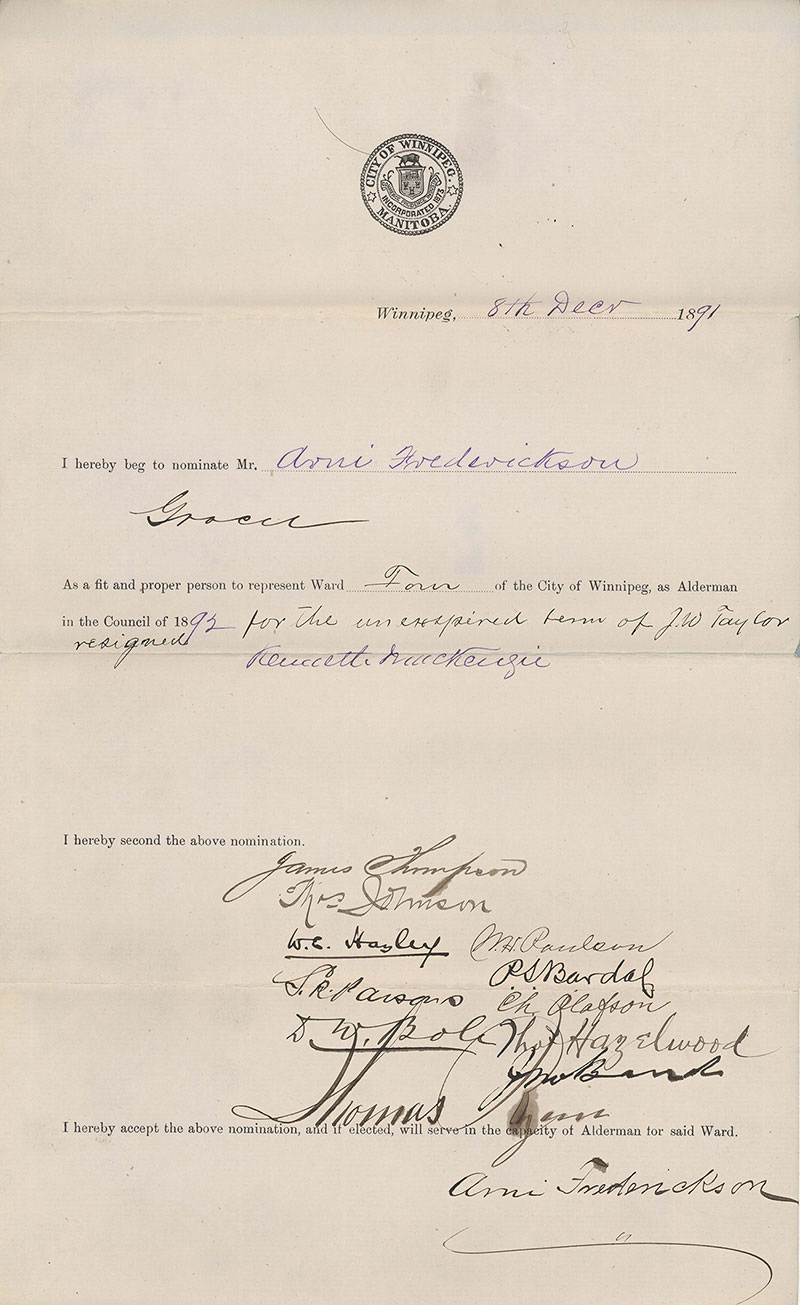
Nomination Form, Arni Frederickson, Election Papers, 1891. (A787 File 10) |
Women on Council
While women were eligible to vote in civic elections in Winnipeg as early as 1887, they were not able to hold office until 1916. The first woman to run for Council was Alice A. Holling Alice Holling ran in Ward 7 in 1917, but was defeated. She ran in 1921 in Ward 2, but was again defeated. Her nomination form states only that she was a “married woman” (Mrs. Luther Holling). However, she was an active member of the Political Equality League, other members of which were Lillian Beynon Thomas, E. Cora Hind, Dr. Mary Crawford and Nellie McClung.
X Close. She ran in 1917 in Ward 7, but lost to Alexander McLennanBorn in 1851 in Inverness, Scotland, Alexander McLennan arrived in Canada at the age of 26 and established himself as a contractor in Winnipeg in 1880. He was first elected to City Council in a by-election in 1913 in Ward 7. He ran and won in 1913, 1915 and 1917, but was defeated in 1919. He died in 1921.
X Close, 693 votes to 358 votes.
The first woman elected to Council was Jessie KirkJessie Kirk was the first woman elected to Winnipeg City Council. She was a schoolteacher, but lost her job because of her labour activities.
X Close. She ran in Ward 2 in December of 1920 and served a two-year term on Council. She ran again in 1922, 1923, 1926 and 1934, but was defeated each time.
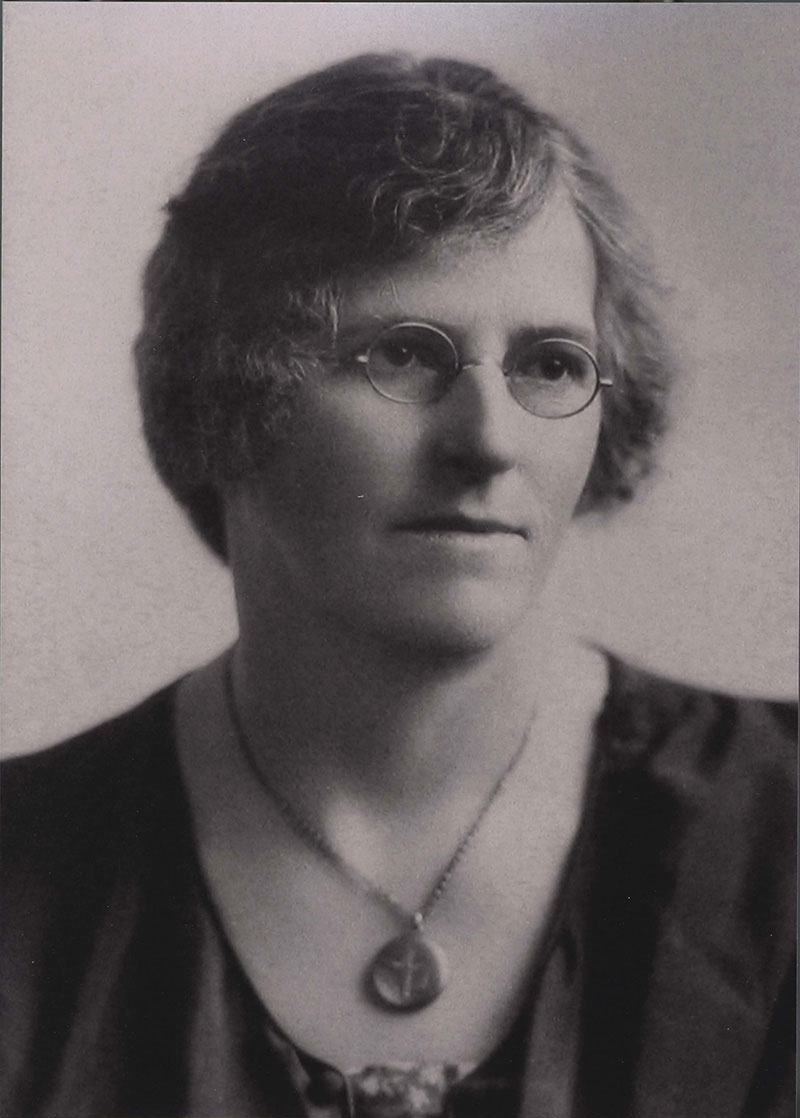
Jessie Kirk. Detail from photomontage, 1921. (P7 File 35) |
Council Work
The City’s first Council established standing committees on Finance, Printing, Board of Works, Markets, Fire and Water, and Assessment. Council then began to establish itself through the passage of by-laws. Twenty-seven by-laws were passed in the City’s first year of incorporation. Perhaps the most significant were By-Law No. 5 – which confirmed the appointment of two assessors – and By-law No. 20 – which authorized the first assessment of property within the City. The City was now able to generate revenue and begin the task of turning a lawless frontier town into a dynamic social, cultural and economic centre.
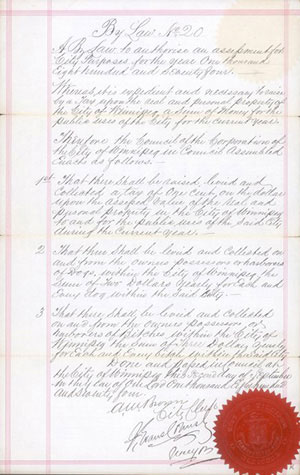
By-Law No. 20, 1874. |

